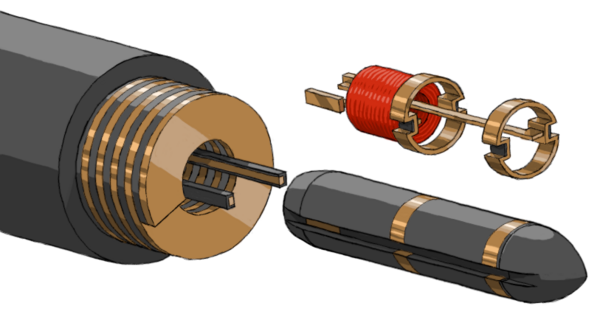Helical railguns
Helical railguns are a kind of railgun-coilgun hybrid. In operation, they are basically a brushed synchronous electric motor that has been rolled out into a straight line. In this concept, there are two rails inside the bore of a helical winding. The helix is never directly energized except via contact with the projectile. Current flows up one rail and into a sliding electrical contact on the projectile (called a "brush" when using electric motor terminology). From the brush, the current is then directed into a co-axial electromagnet (which forms the armature, in the electric motor analogy). After exiting from the electromagnet, the current passes into a circular brush around the circumference of the projectile. This brush makes electrical contact with the helix, such that the current flows in a spiral around the helix to reach a second circular brush, which turns that portion of the helix between the two brushes into an electromagnet. The current then passes into the second circular brush and back to another rail brush where the current exits and flows back down the other rail. The electrically magnetized armature is attracted to or repelled from (depending on which one is in front and which is in back) the magnetic field of the energized section of the helix (which forms the stator), which accelerates the projectile down the bore.
A helical railgun uses considerably less current than a normal railgun. As a result, much less energy is held in the magnetic field associated with the inductance of the rails. Instead, nearly all the stored magnetic energy is in the energized portion of the helix and in the electromagnet armature. In this way, only the parts of the device that are actively accelerating the projectile have substantial stored magnetic energy. As a result, in theory a helical railgun can be significantly more efficient than a standard railgun.
The helical railgun does not require the complicated switching that a coilgun needs. But it still has the drawback that the projectile makes contact with the barrel, unlike a coilgun which can work with a levitated projectile. This introduces frictional losses, heating, and wear on the rails and helix.
|
Diagram of the internals of a helical railgun. The stator, including the rails and the helical winding, are on the left and form a barrel (covered with a mechanical support to withstand the forces of firing). The full projectile is shown on the right bottom, and the active portions of the electrical system of the projectile at top right. Copper-colored material is conductive, grey material is insulating, and the red indicates a winding of an electromagnet. |
